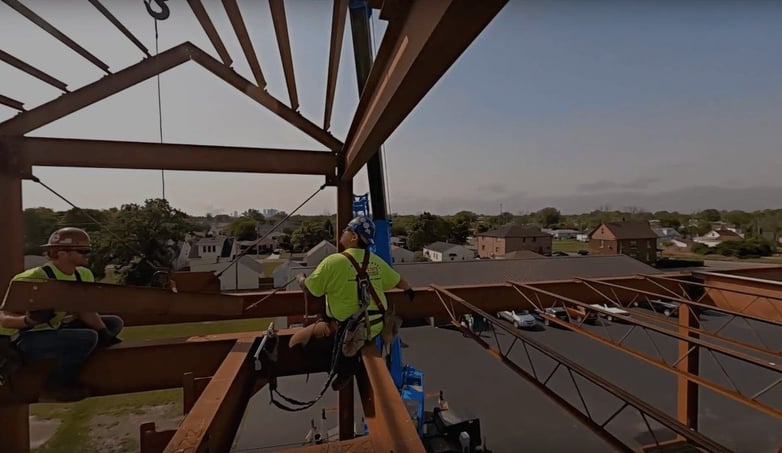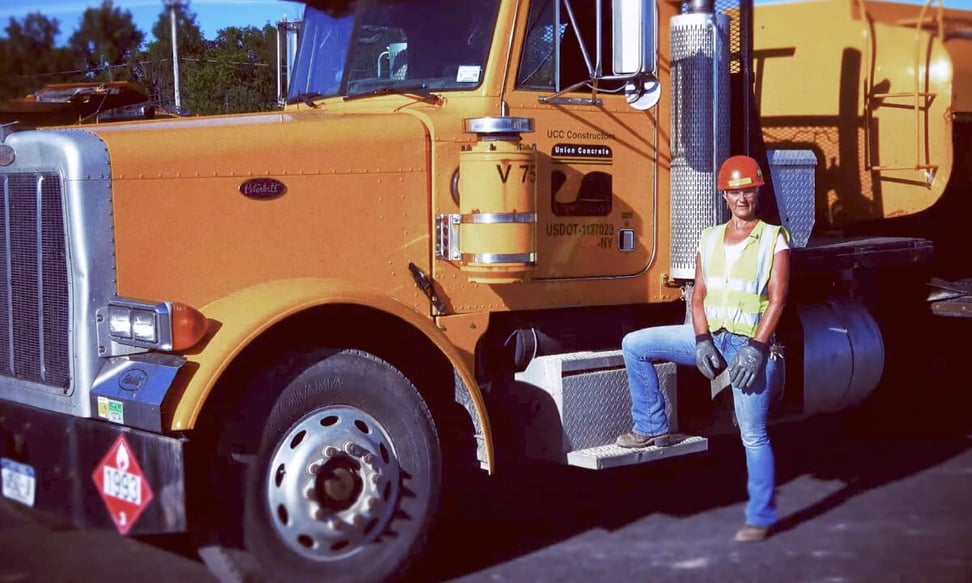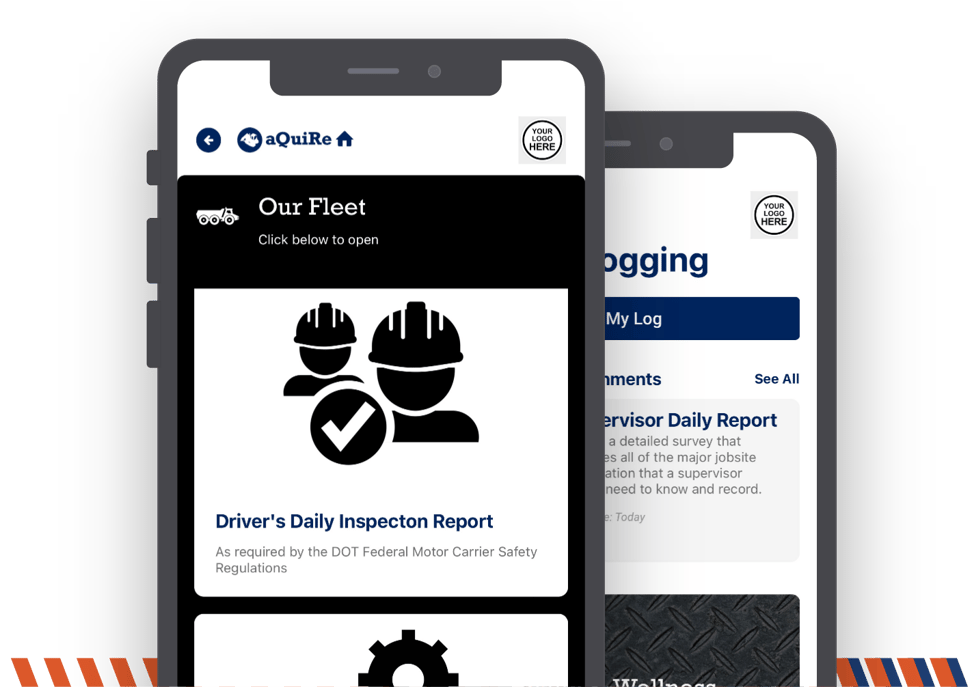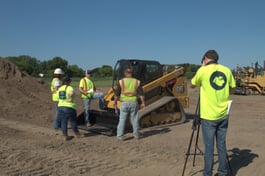
- Intro
- Lack of workforce in the construction industry
- How to attract construction workers?
-
The aQuiRe platform - training and compliance tool for your crew
Construction companies have many challenges to face as they work to ensure their projects are delivered on time and within budget. It is a complex world where labor is critical, and equipment and materials are expensive. There is little room for mistakes, so planning and execution must be managed carefully. Company leaders have to be innovative and proactive when finding solutions to the many challenges that can disrupt a project, stay ahead of the competition, and deliver results.
When it comes to workplace safety in construction, there is no such thing as a "quick fix." Making your worksite safe requires a commitment of time and resources. But many contractors don't realize that this investment can have a significant return on investment (ROI).
OSHA studies indicate that for every $1 invested in construction safety programs, there is an average ROI of $5 as illnesses, injuries, and fatalities decline. This means that not only will a well-run safety program save lives and prevent injuries, but it will also improve your bottom line.
Lack of workforce in the construction industry
One of the most significant challenges that construction companies face is a shortage of skilled labor. Finding workers has been difficult for decades, but it has been especially challenging in today's tight labor market.
The industry has been hit hard by the retirement of Baby Boomers and the lack of young people entering the workforce to replace them. This has led to a decrease in productivity and an increase in costs as companies struggle to find workers with the necessary skills. If they can't hire the right people at the right time, projects will be delayed, or corners will have to be cut, causing safety exposures.
To address this challenge, construction companies need to focus on finding new ways to attract and retain workers. This may include offering competitive salaries and benefits, providing training and development opportunities, and creating an attractive culture for young people.
In addition, it is important to invest in safety so that workers feel confident knowing they will be protected from workplace injuries, illnesses, and fatalities. When workers feel safe, they are more likely to stay with a company and be productive.
How to attract construction workers?
Construction companies realize they need to do more to attract a quality workforce. They must ensure they have a good reputation so people want to work there and focus on employee retention by creating a positive work environment with competitive salaries and benefits.
Leading companies also understand they need to focus on safety to attract and retain workers. Implementing a safety management system that provides workers with the information they need to avoid pitfalls and manage field conditions is critical to ensuring a safe work environment.
Offering safety training and development opportunities is another way to attract and retain top talent. Providing workers with the opportunity to learn new skills and knowledge will help them advance in their careers while benefiting the company by increasing productivity.
Creating a safety culture

Safety culture is an organization-wide commitment to safety. It starts with company leadership setting the tone and expectations for safety and extends to every employee understanding their role in keeping the worksite safe.
A strong safety culture requires open communication about hazards and potential risks and a dedication to continual improvement. It also includes holding employees accountable for their actions and providing them with the resources they need to stay safe.
Investing in safety will help you attract and retain top talent, improve productivity, and reduce costs. Creating a culture of safety will also help you avoid potential liabilities and protect your most valuable asset - your workers.
Direct and indirect costs of safety
The direct costs of safety are those that are incurred to implement and maintain a workplace safety program. These can include the costs of training, equipment, and supplies.
The indirect costs of safety are those that are not directly related to the implementation of a safety program but can be attributed to it. These can include medical expenses or the costs of lost productivity due to injuries, illnesses, and fatalities.
The costs of safety should be considered when making decisions about whether or not to invest in a safety program. While the upfront costs may seem high, the indirect costs of not investing in safety are often much greater.
In addition to the monetary costs, there are also intangible costs associated with safety. These can include the emotional toll of an injury or fatality, as well as the damage to a company’s reputation.
The aQuiRe platform - training and compliance tool for your crew

All the challenges mentioned above are the reasons we created the aQuiRe app. The construction partners we work with use the app to assist with culture change. By showing a progressive way to give workers an attractive and defined career path, they break down many barriers keeping prospective employees from Skilled Trades careers.
The aQuiRe platform comes with a broad library of safety, compliance, and training modules, available at all times through the simple, purpose-built app. Easy to follow and interactive, the app content is designed to get new hires productive quickly and support the development of existing employees.
The library includes hundreds of topics on specific machine operations, maintenance methods, operations tips, and safety techniques. These Skills are organized for quick access with greasy hands and work gloves. The app is available for both Android and iOS devices, allowing employees to access the content at any time, from anywhere.
How to ensure safety and compliance with aQuiRe
The aQuiRe platform provides management peace of mind by ensuring all critical job site processes are followed. The government has many specific Safety directives about the activities that must be carried out on a construction site, and they want you to prove you're following them at all times.
The aQuiRe app comes with a Standards Logging capability that allows workers to show they follow each of those directives and alerts the leaders of any anomalies that may require action.
Some construction companies have their own standards that go beyond government directive compliance activities. Using the aQuiRe app, they can create and share methods for maintaining their equipment at the optimal time and level. This helps reduce wear and tear, improve safety, and extend the life of the equipment.
Companies may also include specific instructions for their procedures, such as how to safely survey a site or perform an operations procedure for a seldom-used machine. This gives workers the confidence needed to perform infrequent tasks and leaders the peace of mind that comes from knowing their standards and policies are being followed.
aQuiRe is the only platform that offers an end-to-end solution for the construction industry's safety, compliance, and training needs. If you're looking for a way to improve safety on your job site and ensure compliance with government directives, aQuiRe is the answer.
Improve worker performance and safety ROI

Improved worker performance saves labor, makes projects run more seamlessly, and lowers safety ratings and the resulting costs of insurance. It all comes back to giving employees the confidence and tools they need to do their jobs well.
The aQuiRe platform helps you improve worker performance and safety ROI in several ways:
- By providing access to safety, compliance, and training content at any time, from anywhere
- By holding employees accountable for their actions and providing them with the resources they need to stay safe
- By creating a culture of safety that attracts and retains the best workers
- By reducing wear and tear on equipment and extending its life.
Let's look at one of our current client's results to illustrate the impact. A road and bridge builder with 120 peak season workers calculates that a typical workplace accident (non-fatal injury) costs $71,580.
Since incorporating the aQuiRe app into daily operations, their incident rate has decreased by two. That resulted in net savings of $143,000. Since the program cost is less than $22k per year, this contractor shows a 7x return on their aQuiRe investment. And we're not talking about a one-time saving; this is an annualized number.
This analysis does not consider the additional benefits of the aQuiRe app, such as:
- Improved labor efficiency by cross-training workers
- Providing a career path for workers to improve skills and advance
- Attracting new, qualified workers to the company
- Reduced need for rework and scrap
- Eliminating the time and resources needed to manage paper processes
- Ability to continuously prove compliance
- The improved reputation of the company.
Final words
When it comes to safety in construction, there is no such thing as a "quick fix." Making your worksite safe requires a commitment of time and resources. But the rewards are well worth the investment.
Saving $143k on a $22k investment shows a 700% return on invested capital. Most construction companies would consider investing in any project that returns 25% on their investments. But 700% return? That's an aQuiRe no-brainer.
If you're looking for a way to improve safety, compliance, and worker performance on your construction site, we invite you to try aQuiRe.
.jpg?width=82&name=CaHill%20Headshots%202022%20final_0006_Laura%20Haykel%20(1).jpg)


